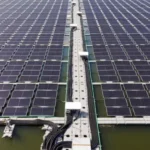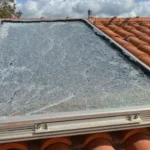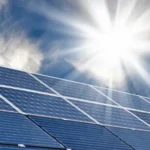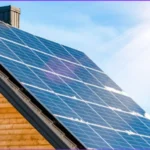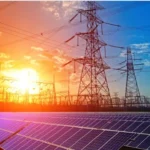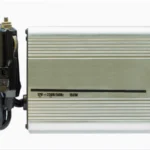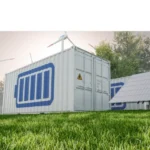Ever wondered what happens to your solar power outage ? It’s a question I get all the time from homeowners and small business owners: If the grid goes down, won’t my solar panels keep powering my house?The short answer: not necessarily, and understanding why can save you from a cold fridge, a dead phone, and a lot of frustration the next time the power blinks out.
In this guide, we’ll walk through how solar systems behave in outages, the role of batteries and smart inverters, and how you can prepare so your investment keeps paying off even when the grid is dark.
Also visit here : Solar panel hail damage.
Why Most Solar Systems Shut Down During a Power Outage
Here’s the surprising part: grid-tied solar systems are designed to stop producing electricity during an outage.
This isn’t a flaw, it’s a safety feature called anti-islanding. If your panels continued to send power into the grid while utility workers were repairing lines, it could be life-threatening for them.
According to the U.S. Department of Energy’s Energy Saver guidelines, this safety shut-off is standard for all grid-connected solar arrays unless you have backup capability.
Real-world example: A client of mine in Tempe, Arizona, assumed her new 7.5 kW rooftop system would keep her lights on during a storm-induced solar power outage. But without a battery bank or hybrid inverter, her panels shut off the moment the grid goes down. We ended up retrofitting her setup with a 10 kWh lithium-ion battery and an inverter with “islanding” capability so she could operate off-grid in emergencies.

Solar Power Outage Solutions — Batteries, Generators, and Hybrid Inverters
If you want solar to work during a blackout, you’ll need one or more of the following:
1. Solar Batteries
- Function: Store excess solar energy for use at night or during outages.
- Example: A Tesla Powerwall or LG Chem RESU can power essential circuits (fridge, lights, Wi-Fi) for several hours or even days if you conserve.
- Pro tip: Choose a system that can recharge directly from your panels while disconnected from the grid.
2. Hybrid Inverters
- These combine grid-tied and off-grid capabilities, automatically switching your system to “island mode” when the grid fails.
- Many newer hybrid inverters include smart load management, so you can prioritize critical appliances.
3. Backup Generators
- Downside: They burn fuel and require maintenance, but can be a cost-effective safety net for longer outages.
- Best use case: Rural areas where power restoration may take days.
Also visit here : Solar world.
How to Prepare Your Solar System for an Outage
Even the most advanced solar battery setup is useless if it’s not ready when you need it. Here’s how I advise clients to prepare:
Step-by-Step Outage Prep
Know Your Critical Loads
Make a list: refrigerator, medical devices, modem/router, LED lights, phone chargers.
Test Island Mode
Work with your installer to simulate a grid failure and see how your system behaves.
Check Battery Health
Keep batteries at optimal charge (typically 80–90%) and avoid deep discharges when not necessary.
Update Firmware
Smart inverters often get efficiency and safety updates, so do not skip these.
Panel Maintenance
Dirty panels can reduce output by up to 20%. In an outage, every watt counts.

A Homeowner’s Perspective — Living Through a Solar Power Outage
Back in 2022, a summer monsoon took out power for nearly 14 hours in my Phoenix neighborhood. My own system, 6.8 kW panels and a 13.5 kWh battery, kicked in within seconds.
Key takeaways from that day:
- I kept my fridge, lights, and internet running, but intentionally turned off the AC to preserve battery life.
- My panels recharged the battery to 60% by midday, even with partly cloudy skies.
- Neighbors without storage relied on ice chests and flashlights.
It wasn’t glamorous, but it was functional resilience, exactly why many people invest in storage.
Common Misconceptions About Solar and Outages
Myth 1: “Panels will automatically power my house in a blackout.”
Truth: Not without batteries or a special inverter.
Myth 2: “Batteries can run my whole home for days.”
Truth: Depends on your battery size and energy use. A single 10 kWh battery might power essentials for 12–24 hours.
Myth 3: “Any installer can set up backup mode.”
Truth: Only certified professionals should configure hybrid systems. Incorrect wiring can be dangerous.
Efficiency Matters — Maximizing Output Before an Outage
During an outage, system efficiency isn’t just about saving money, it’s about survival comfort.
Tips to Keep Your Solar Performing at Its Peak
- Regular Cleaning: Dust, pollen, and bird droppings can slash output by 15–20%.
Quick anecdote: One customer in Tucson saw her daily output jump from 22 kWh to 27 kWh just by cleaning panels after a particularly dusty week.
- Shade Management: Trim trees that cause shading during peak sun hours.
- Inverter Monitoring: Check your production data monthly. If output dips unexpectedly, it could signal a wiring or panel issue.

Solar for EV Owners — Charging When the Grid Is Down
If you drive an electric vehicle, a solar power outage could leave you stranded unless you prepare.
Best Practices:
- Install a Level 2 charger compatible with your solar plus battery system.
- Avoid full charges during an outage unless necessary. Save capacity for essential home loads.
- Consider vehicle-to-home (V2H) tech. Emerging EVs like the Ford F-150 Lightning can actually power your home from the vehicle battery.
Off-Grid and Remote Applications
For cabins, RVs, or tiny homes, outages are irrelevant. Your system is already independent.
Key Off-Grid Considerations:
- Sizing your battery bank for at least 3 days of autonomy.
- Choosing durable, weather-resistant panels rated for your climate.
- Incorporating backup generation (diesel, propane, or wind) for extended cloudy periods.
ROI and Peace of Mind — Is Backup Worth It?
Backup capability does add cost:
- Battery systems: $8,000–$16,000+ installed
- Hybrid inverters: $2,000–$5,000 depending on capacity
But the value isn’t just financial. It’s in the security of uninterrupted power.If you run a home office, rely on medical equipment, or live in an outage-prone area, the return on investment can be immediate the first time you avoid a spoiled fridge or lost business day.
Final Thoughts — Don’t Wait for the Next Blackout
A solar power outage doesn’t have to mean going without electricity. With the right combination of batteries, smart inverters, and preparedness, you can turn your solar system into a true backup solution.
If your panels haven’t been cleaned in over 3 months, you could be losing 10–20% of your energy output, which is critical power you might need in an outage. Schedule a solar inspection today and make sure your system is ready for anything.


